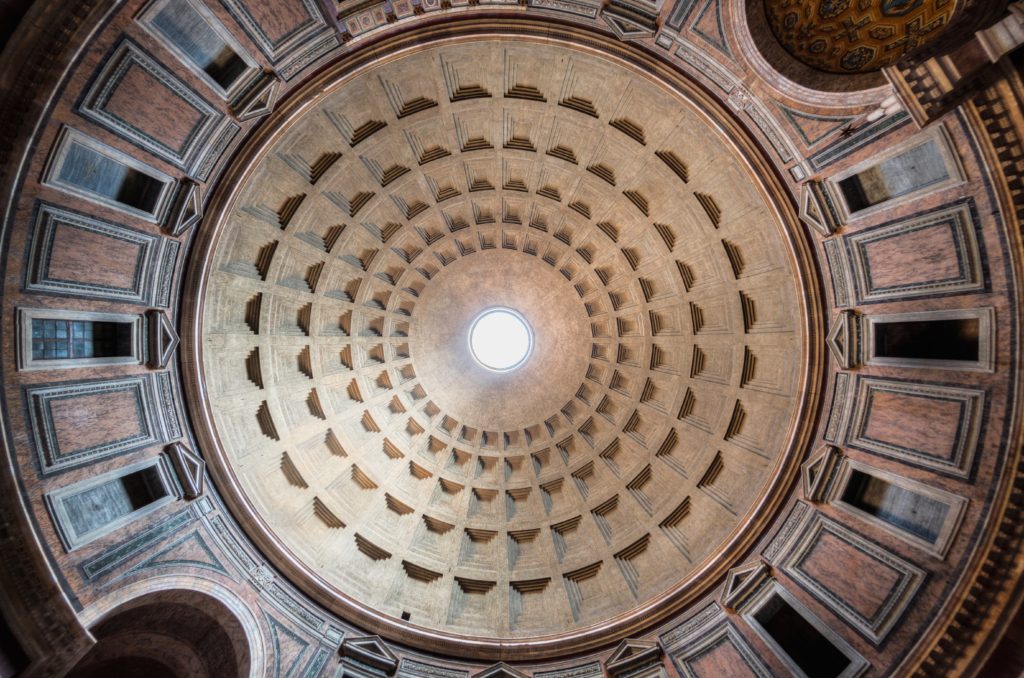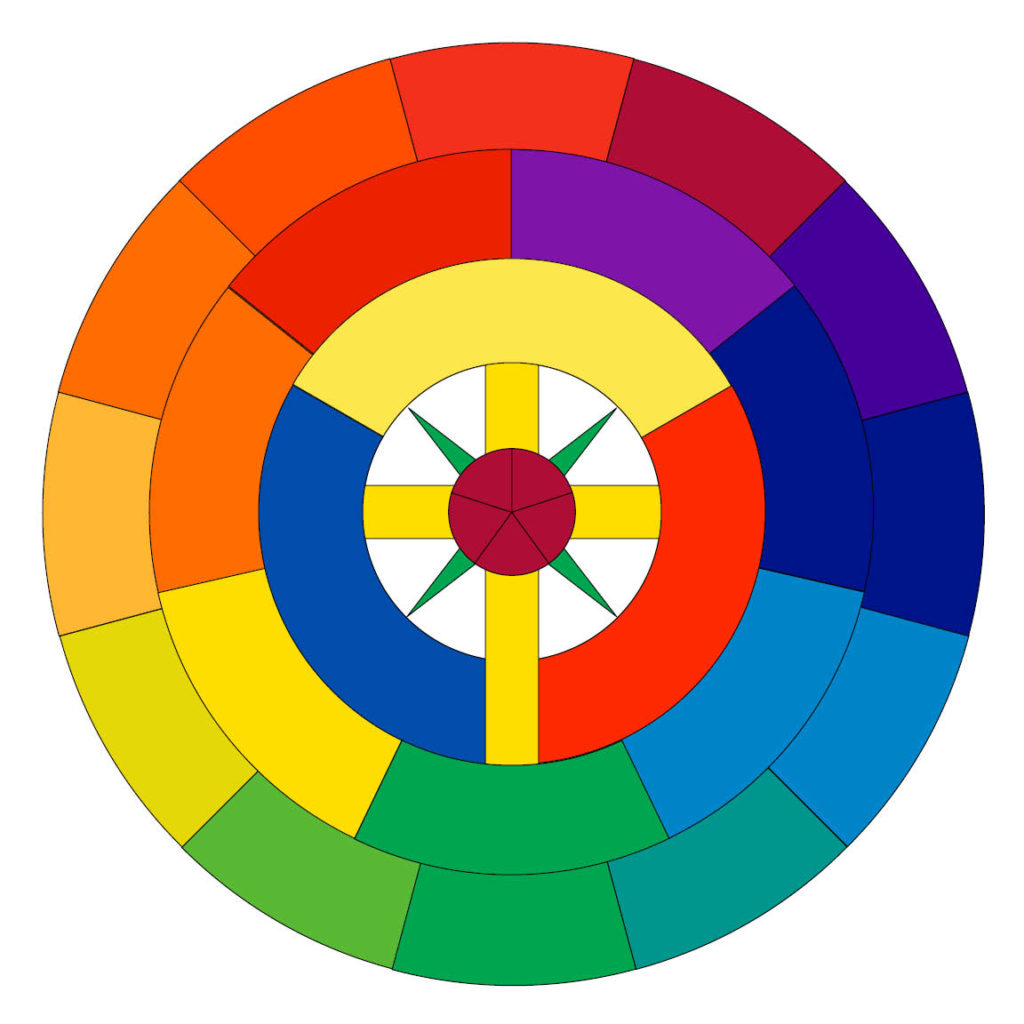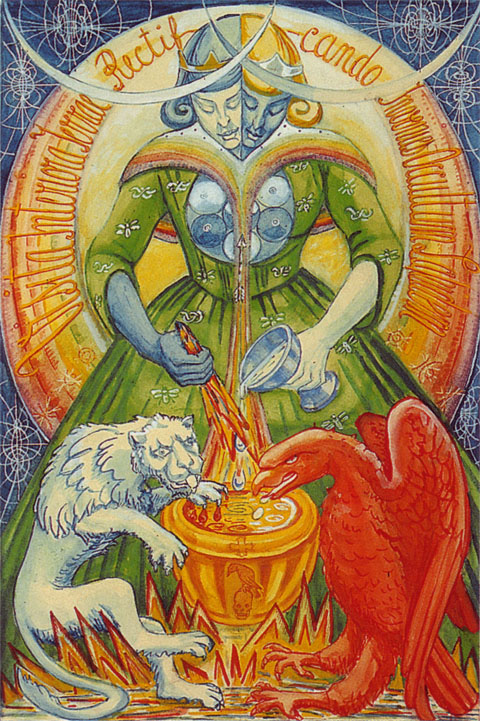
There’s this ancient temple in Rome called the Pantheon. It has a giant domed ceiling with a hole right in the center of it. I visited it in my 20s. I think “grand” is the right word to describe it. It’s not easy to capture in a photo.
When I think about the relationship between magick (especially theurgy) and mysticism, I recall what it was like looking up at the ceiling of the Pantheon from inside. I imagine the flower of the rose-cross painted on the ceiling, the opening in the middle being where the central cross would be. The multi-colored petals would be painted around the hole.

Whether you’re practicing theurgy or yoga, you’re aiming up in both cases. It’s just a question of how you aim. When you unite yourself with some particular god or goddess—or if you’re just working with some particular path—that’s aiming toward one of the petals off to the side of the central opening. But yoga is like aiming in a direct, vertical line through the hole in the roof.
Of course that’s exactly how Crowley thought of Knowledge and Conversation of the Holy Guardian Angel as well. The Holy Guardian Angel is on the middle pillar of the Tree of Life.
The magician devotes himself entirely to the invocation of a God, and as soon as his balance approaches Perfection he ceases to invoke any partial God; only that God vertically above him is in his path. And so a man who perhaps took up magic merely with the idea of acquiring knowledge, love, or wealth, finds himself irrevocably committed to the performance of the great work.
Magick in Theory and Practice, Chapter 15
I shoot up vertically like an arrow, and become that Above. But it is death, and the flame of the pyre. Ascend in the flame of the pyre, O my soul! Thy God is like the cold emptiness of the utmost heaven, into which thou radiatest thy little light. When Thou shall know me, O empty God, my flame shall utterly expire in Thy great N. O. X.
Liber VII, I.37-40
The O.T.O. IX° working is also a middle pillar working. It is attributed to the path of Samekh, the path uniting the Sun (Tiphareth) with the Moon (Yesod). Its hieroglyph depicts a Lion and an Eagle exchanging their essences into a cauldron. The Caput Mortuum drops to the bottom of the cauldron as spiritual air (Aleph, Baphomet) rises. This rising spiritual current is the “Rashith-ha-Gilgalim of the new Universe created of the Quintessence of the Substance of the Unity of the Angel and the Adept, expressed therefrom by virtue of ‘love under will’ at the moment of Rapture.” (Commentary on LXV V.1) This is the spiritual essence unlocked from the Eucharist of One Element, the Medicine of Metals. It is like a cosmic stem cell which can be molded into any physically possible state of affairs by the magician.

In other words this issue of working the middle pillar applies both to the Knowledge and Conversation of the Holy Guardian Angel as well as the IX° magick. It applies to the mysteries of both A∴A∴ and O.T.O.
This mystery is represented analogously in the Gnostic Mass. Here it is depicted using a eucharist of two elements rather than one. The Priestess is like the Angel of the Priest, and the “moment of rapture” is symbolized when they cry HRILIU.
Another way to put it is that in the case of yoga, one aspires up the middle pillar, but in this particular kind of magick, one manifests a current down the middle pillar (into the organs of generation, which are represented on the Tree of Life by Yesod). Generally speaking, magick is a movement of energy “down the Tree”. The impulse originates with the Will in Chokmah and is given form on the astral at Yesod before manifesting in Malkuth. Yoga, theurgy, and path workings tend to be ascensions “up the Tree”. Both operations (yoga and magick) require mastery of the subtle energetic currents represented by the entire Tree of Life, though.
It’s a commonplace to talk up “balance” in relation to Crowley and Thelema, but it really is an essential theme. “Balance” will mean different things to you at different points of your spiritual development. There’s balance of the elements within your conscious experience. There’s a balance point or borderline between conscious and unconscious which has to be worked with more or less interminably. There’s contrasexual balance points.
What happens typically is that you experience a “calling” into some terra incognita. This might be an entirely new calling, or it might be some perennial difficulty in your life. But it will draw out what Jung called a complex. The easiest way to describe a complex is that you just don’t feel like yourself anymore. You feel like you’ve temporarily become a different person. If you are usually self-controlled, you’re suddenly impulsive. If you’re usually strong, you’re suddenly clingy and weak. If you’re usually kind, you’re suddenly sadistic. And then you have to work with that imbalance in order to get yourself back to a place of balance.
God is above sex; and therefore neither man nor woman as such can be said fully to understand, much less to represent, God. It is therefore incumbent on the male magician to cultivate those female virtues in which he is deficient, and this task he must of course accomplish without in any way impairing his virility. It will then be lawful for a magician to invoke Isis, and identify himself with her; if he fail to do this, his apprehension of the Universe when he attains Samadhi will lack the conception of maternity.
Magick in Theory and Practice, Chapter 1
In my opinion, Crowley’s description of this process here is perfunctory, even blithe.
In any case, there’s really no formula for this. I’m not even going to try to offer “helpful hints” on it. But generally speaking, that’s the work of magick or going “off-center” as I described above.
